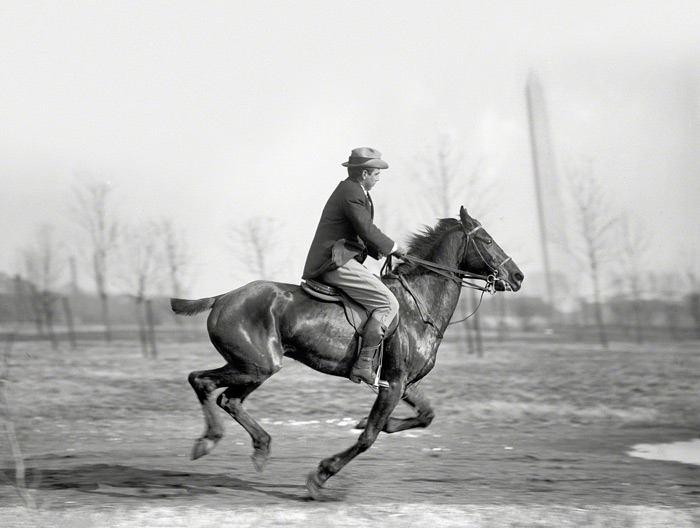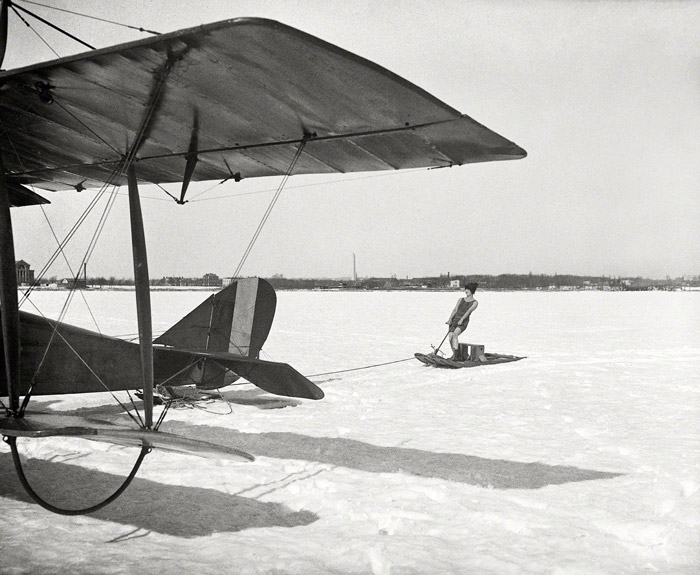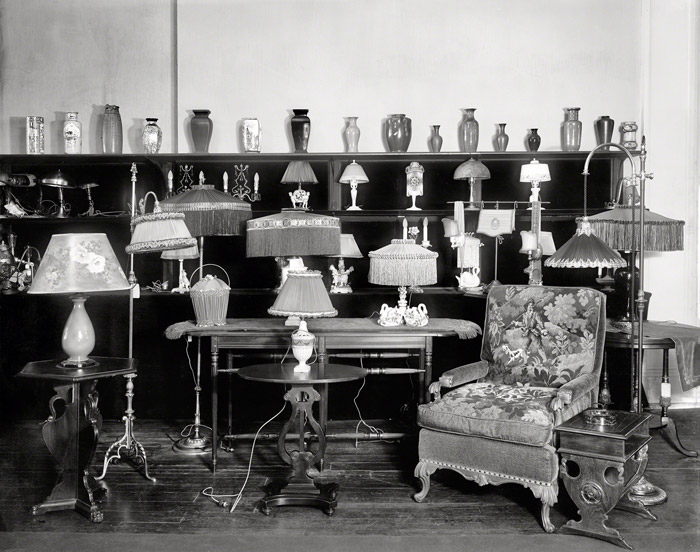Hole in the Clouds
Sep 1, 2012
 In the archives of the old Harris & Ewing photo studio in Washington, D.C., is the glass negative for this picture, with no caption information whatsoever.
In the archives of the old Harris & Ewing photo studio in Washington, D.C., is the glass negative for this picture, with no caption information whatsoever.
What think you? A posed shot to promote new lawnmowers with Ajax Ball Bearings? Political imagery to promote a candidate with hard-working American (grass)roots? Somebody's aunt?
1920s? 1940s?
Couple of thoughts: Years ago, we lived in a neighborhood of Tuscaloosa, Alabama, where most of our neighbors were older people. By then, lawnmowers had gasoline engines, but I recall that pushing them was considered women's work. More recently, when we lived in Maine, I often saw older couples out in the morning clearing their walks with gasoline-powered snowblowers. The division of labor for this task was that the man walked behind the snowblower while the woman worked alongside with a shovel.
What I like best about this picture: the pearls.
Washington
work
yard
DC
lawnmower
1930s
(Image credit: Harris & Ewing via Shorpy)
Mar 10, 2013
 Although George Chaconas advertised "fancy fruits and vegetables" at his grocery store in Washington, D.C., also prominent among his wares are chickens with their feathers and rabbits with their fur.
Although George Chaconas advertised "fancy fruits and vegetables" at his grocery store in Washington, D.C., also prominent among his wares are chickens with their feathers and rabbits with their fur.
Way in the background is the Washington Monument. The store was in the area now swallowed up by the government office buildings of Federal Triangle.
By 1915, when this picture was taken, Chaconas had been in the grocery business for more than a quarter century. In addition to the store, which had been in this location for about a decade, he and his family also sold groceries from a truck–the kind of vehicle referred to then as a huckster wagon–that made the rounds of the outlying neighborhoods.
Back in the 1890s, however, when he was first establishing himself in Washington, Chaconas sold his fruits and vegetables from a pushcart. On August 14, 1894, as recorded by the Washington Post, Chaconas and eleven other Greeks and Italians were arrested and fined for lingering too long and obstructing traffic with their pushcarts.
streetscape
store
P.K.
1915
immigrant
Greek American
chickens
(Image credit: Harris & Ewing via Shorpy)
Oct 2, 2013

Ninety-nine years ago, in the winter of 1914, a Washington lawyer by the name of Wrisley Brown could fly on horseback across West Potomac Park without encountering traffic or tourists or even another horse.
Woodrow Wilson was president then, and the world was different. But when I was a little girl, which spanned a few years roughly halfway between the Wilson era and the current unpleasantness, people still rode horses in West Potomac Park, at least on summer Sundays, when the polo teams were playing. The Internet tells me that polo still happens there, with the Washington Monument as backdrop, or at least still happened there this past summer; presumably, it could also happen again next summer if the Republicans decide to unshut the government and reopen the park.
The Washington Monument is listing leftward in this picture, as are the trees in the park. That's an artifact of 1914 photographic technology, which utilized a slit in a spring-wound sheet-metal shutter to allow light focused by the lens to reach the glass-plate film. The slit would drop from top to bottom to expose the plate, but because there was a lens in front of the slit that inverted the light rays, the plate was actually exposed from bottom to top. And meanwhile, for this picture, the photographer was panning from left to right to follow the moving horse. Objects that weren't moving kinda got an angle to them.
A couple of years ago, the Washington Monument came close to acquiring a much more serious lean. The monument took a $15-million blow from a 5.8 earthquake and remains shrouded today in scaffolding, for repairs that probably are not considered important during a government shutdown, even though half the bill has been covered by a private philanthropist. We just can't have nice things any more because, you know, because.
They can play their polo somewhere else, I don't have a problem with that, but who are these people who think it's okay to let the Washington Monument fall to pieces?
horse
1914
Wrisley Brown
West Potomac Park
Washington Monument
D.C.
(Image credit: Harris & Ewing via Shorpy)
Feb 14, 2014
 "Woman on sled being pulled by biplane, with Washington Monument in the background." February 1922.
"Woman on sled being pulled by biplane, with Washington Monument in the background." February 1922.
Washington, D.C.
snow
1922
sled
(Image credit: Harris & Ewing via Shorpy)
Sep 8, 2014
 The latest and greatest in electric lights, as seen in 1917 in the Washington, D.C., showroom of Dulin & Martin Co.
The latest and greatest in electric lights, as seen in 1917 in the Washington, D.C., showroom of Dulin & Martin Co.
Note that the business ends of the lamp cords were shaped like the bottoms of light bulbs. Those were the days when houses were wired with sockets for light bulbs but not with wall outlets; to plug in a lamp or a toaster or any other kind of electrical appliance, you'd first have to unscrew a lightbulb from the ceiling.
Washington, D.C.
store
1917
lamps
Dulin & Martin Co.
(Image credit: Harris & Ewing via Shorpy)
 In the archives of the old Harris & Ewing photo studio in Washington, D.C., is the glass negative for this picture, with no caption information whatsoever.
In the archives of the old Harris & Ewing photo studio in Washington, D.C., is the glass negative for this picture, with no caption information whatsoever.


